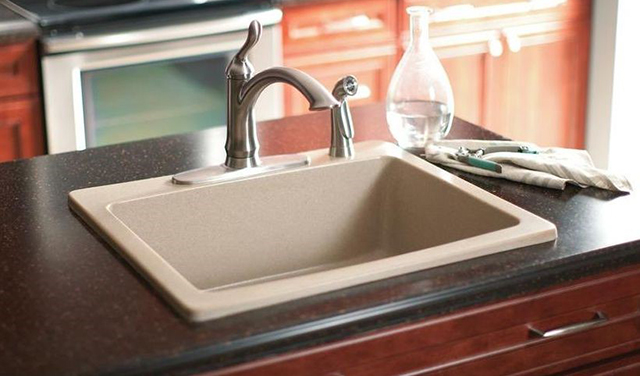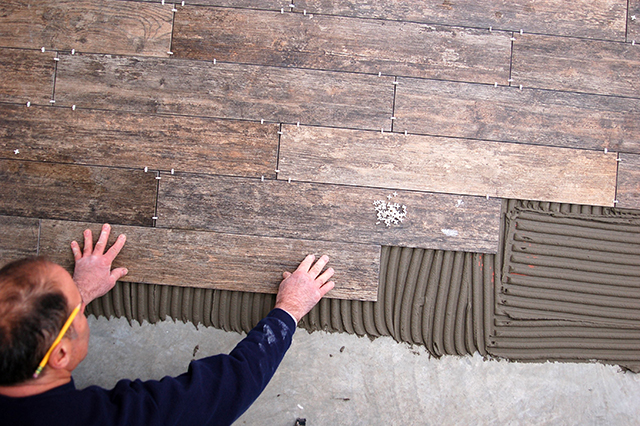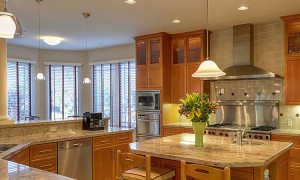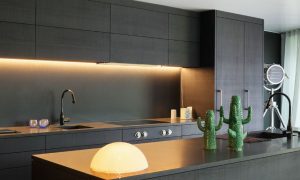A key component of any kitchen remodel is selecting new products that fit with your design, budget and construction timeframe. Here, we’ll take a brief look at six categories of kitchen-remodeling products. With several models, options and variations within each category, picking the right product for your specific kitchen can seem daunting. However, it’s actually a lot of fun and easier than you might think. First, here are some things to keep in mind:
1. Personal Taste: You’ll likely eliminate a large number of the choices simply because of personal preferences with regards to style, color, shape, size and features.
2. Construction Time Frame: This will also help reduce the number of product choices. If you hope to complete the remodel in four to six weeks, then there’s no point looking at any cabinets or counters that can’t be delivered within that time period. The same goes for contractors. Only consider those who can commit to your construction schedule.
3. Price: Price plays a key role in purchasing any product, but again, focus on the products that fit within your budget, and you’ll dramatically streamline the decision-making process.
Considering these three important factors throughout the process will make product selection much simpler. We’ll start by providing information on cabinets and then move to countertops, appliances, sinks, flooring and lighting.
Cabinets
Price is a good indication of quality when purchasing any product, including kitchen cabinets. More expensive cabinets are usually better built and equipped than cheaper cabinets, so look beyond the cabinets’ stain color and style and focus on the quality of construction.
Reface vs. Refinish
Think about your remodeling objectives: Which places in your kitchen might you be able to give a facelift instead of a total overhaul? You can save a considerable amount of time and money by having the cabinets professionally refaced or refinished instead of purchasing entirely new ones.
Reface: With cabinet refacing, you essentially get the look of a brand new kitchen. The current cabinet frames remain intact, but the doors, drawer fronts, hinges, handles and pulls are replaced. The existing face frames of the cabinets are veneered to match the new doors and drawers. The great thing about refacing, besides the obvious savings, is that you can choose from many different styles and colors of doors and drawers to completely change the look of your kitchen—without replacing a single cabinet. You’ll also save a considerable amount of time and soon be back to cooking in your own kitchen.
Refinish: For an even quicker, more affordable makeover, consider having the cabinets refinished. With refinishing, the existing cabinets stay put, but the old finish is stripped off of the doors, drawer fronts and face frames. Then, a new finish is applied, which affords you the opportunity to change the color of the cabinets if desired. All the hinges, handles and pulls are replaced with new hardware.
Once you’ve renewed the cabinetry, you can turn your attention to remodeling the rest of the kitchen, including the countertops, appliances, flooring, lighting and any upgrades to the electrical and plumbing systems.

You may be able to reface, not replace, your cabinets with all new drawer faces and doors.
Cabinet quality is determined by examining three components:
1. The Case (carcass): The case is typically built of plywood, particleboard or medium-density fiberboard (MDF). Plywood holds nails and screws better, can be stained and is less susceptible to swelling and moisture damage. However, particleboard and MDF are better substrates for plastic laminate, thermo-foil and melamine. Also, some sink cabinets are molded entirely out of plastic, making them impervious to water damage.
2. Drawers: The best drawers are built of solid wood with plywood bottoms. Plywood drawers are less expensive and nearly as durable as solid wood. Particleboard is the least expensive and is a lightweight option good for DIY projects. It also does not warp due to temperature fluctuations. Drawers assembled with dovetail joints are stronger and more durable than those built with rabbet or doweled joints.
3. Hardware: Cabinet hardware, specifically door hinges and drawer slides, is another good indication of quality. Look for door hinges that swing open beyond 90° and are fully adjustable in all directions. The Home Depot’s “higher quality” cabinets have full-extension drawers that slide completely out of the cabinet for easy access to the back of the drawer. Bottom-mount drawer slides cost more than side-mount slides, but they’re virtually undetectable when the drawer is open.
Quality cabinets can also be outfitted with soft-touch, self-closing doors and drawers. When a door or drawer is closed within 2 inches or so of the cabinet, it very quietly and slowly closes on its own.
Most cabinet manufacturers offer three lines of cabinets: stock, custom and semi-custom.
1. Stock: Stock cabinets are the most affordable option. They’re produced in standard sizes and warehoused at local distributors and retailers for quick delivery, often in less than a week. Stock cabinets are typically available in 3-inch increments ranging from about 9 to 48 inches wide. You can mix and match various sizes of cabinets to line the kitchen walls. Any remaining space at the end of the run is concealed with a vertical filler strip.
2. Custom: There are no standard sizes; each cabinet is made to fit the exact dimensions of your kitchen. No filler strips are needed. This is the most expensive option, but it produces cabinetry that fits perfectly in your space. Delivery time for custom cabinets varies from one manufacturer to the next, but it typically takes six to eight weeks.
3. Semi-Custom: Semi-custom cabinets are a hybrid between stock and custom. They’re manufactured in standard widths but come in many more sizes, styles, door designs, drawer options, storage accessories, colors and decorative finishes than stock cabinets. Semi-custom cabinets are usually delivered in four to six weeks.

Custom and semi-custom cabinets come in a wide choice of wood species, finishes, and door and drawer designs.
There’s a fourth type of cabinet worth mentioning called RTA, which stands for Ready-to-Assemble. These highly affordable, medium-quality cabinets come in a kit and include all the necessary cabinet parts and hardware. You must assemble each cabinet and attach all the doors and drawers. RTA cabinets are a good choice for budget-sensitive, DIY remodels.

Ready-to-Assemble cabinets provide an affordable DIY option to traditional, fully- assembled cabinets.
Framed vs. Frameless

Kitchen cabinets come in hundreds of sizes and styles, but only two basic types: framed and frameless.
Framed cabinets have a face frame attached to the front of the cabinet. The frame supports a wide range of hinges, including surface mounted, partially concealed and fully concealed.
Frameless cabinets, also called European-style cabinets, have the doors hung directly from the sides of the case with fully-concealed hinges. With no face frame partially blocking the opening of the case, frameless units provide easier access to the interior of the cabinet. However, frameless cabinets are generally considered more difficult to install.
National Kitchen & Bath Association (NKBA) Cabinet Recommendations:
- If waste receptacles are built in, provide one for garbage and another for recyclables.
- At least one corner cabinet should have a functional storage device.
- Cabinets with 36-in. tall eat-at counters should have at least 15 in. of knee space.
Countertops
Countertops are the hardest working surface in the kitchen, so it’s important to select a countertop material that not only looks great, but is also resilient and functional. Today, there are dozens of surfaces available for every budget, ranging from natural stone and renewable acrylic sheets to quartz composites and stained concrete. Countertops come in hundreds of colors, patterns and textures to satisfy design goals ranging from casual to contemporary and sophisticated to sassy.
Below is a chart of eight countertop options, so you can compare and contrast:


Note: Marble is growing in popularity as a countertop material, but be aware that it is relatively soft and porous, so it’s susceptible to staining and scratches. It’s also not as heat resistant as other types of natural stone. If you’d like to use marble in the kitchen, consider it for a baker’s prep area. It’s an ideal surface for rolling out dough.
In this recently remodeled kitchen, granite was used for the main countertops and for the island.
Tour 458 Thunderbowl Ln Aspen, CO 81611

The counters in this country kitchen showcase the warmth and natural beauty of solid hardwood.
National Kitchen & Bath Association (NKBA) Countertop Recommendations:
- Kitchens should have a minimum of 158 in. of countertop space.
- Provide 15 in. of counter space on the handle side of a standard refrigerator, and 15 in. on each side of a side-by-side refrigerator.
- There should be 36 in. of counter space immediately next to the sink for primary food prep.
- There should be a minimum of 12 in. of counter space to one side of each cooking surface and 15 in. to the other side.
Appliances
Today’s appliances are stylish, energy-efficient, extremely durable and packed with an amazing number of innovative, user-friendly features. Plus, they’re available in a broad range of prices to suit any budget.
A. Refrigerators have evolved more over the past 10 years than in the previous 20. They’re available in a number of configurations, including top freezer, bottom freezer, side-by-side and French-door models with two doors and one drawer or two doors and two drawers. There are even freezer-less refrigerators for kitchens that have the space for a separate upright or chest freezer.
Stainless steel and white refrigerators still dominate the market, but they’re also available in black, beige and slate-gray. Some models come “panel ready,” meaning you can have wood panels installed on the doors to match the cabinetry.
Standard refrigerators protrude about 3 inches past the cabinets. If you want the refrigerator to look more “built in,” then buy a counter-depth refrigerator model that will be flush with the cabinets and countertops.
Some refrigerators have a cleverly designed easy-access, double-panel door that allows you to reach items stored on the door rack without opening the main door. French-door refrigerators offer more flexible storage options than other models and are great for storing wide, flat trays. However, they do cost more than other types.

This stainless steel side-by-side refrigerator has an in-door icemaker and water dispenser equipped with an advanced water filtration system.

French-door refrigerators open wide to accept large, flat trays and dishes.
B. Ranges, ovens and cooktops represent the three most popular cooking appliances. Most households can get by with a range, which combines a cooktop stove with an oven, but if you have a large family or like to entertain, then consider adding a wall oven or separate cooktop to expand your cooking and baking capabilities.
When shopping for ranges, there are some things to consider:
1. Electric or Gas: Most home cooks prefer a gas range because it heats up faster and offers greater control. However, electric ranges are typically less expensive and easier to install, waste less heat and provide precise control over cooking temperature. Both types come with one or two ovens.
2. Burners: If you’d like to expand your cooking capabilities without purchasing a wider range, consider upgrading to a five-burner range, which has an oblong, fifth burner set in the middle of the four standard burners.

Many standard 30-in. gas ranges now come equipped with an additional center burner for greater cooking capacity.
3. Single and Double Oven: Double-oven ranges are ideal for kitchens that need a second oven, but don’t have space for a wall oven. With a double oven, you sacrifice the storage drawer typically found below a traditional oven.

Double ovens provide two baking and roasting options while taking up no more space than a standard single-oven range.
4. Freestanding or Built-In: A vast majority of ranges are freestanding models that sit on the floor in between two cabinets. There are also built-in models that are installed within the cabinetry, creating an integral, custom look.
5. Range Hood: Be sure to also pick out a range hood to match the size and finish of the range. A direct-vent hood, which exhausts cooking odors and smoke to the outdoors, is much more efficient than a re-circulating hood that simply sucks air through a filter and then blows it back into the kitchen.
Wall Ovens and Microwave Ovens:
Wall ovens are available in gas, electric and dual-fuel models, with a single or double oven. There are even space-saving models that combine a wall oven with a microwave. Convection ovens, available in ranges and wall models, have an internal fan that circulates the heated air to promote faster, more even baking and roasting.
Microwave ovens are an indispensable part of any modern kitchen. Countertop models, not surprisingly, are by far the most popular type of microwave oven: They’re affordable, require no installation, and can easily be moved around or replaced.
An over-the-range microwave doesn’t require any counter space and doubles as a ventilating range hood.
C. Dishwashers are available in three styles: built-in, portable and drawer model.
1. Built-in dishwashers are the most popular type. They fit between two cabinets and beneath the counter. The standard dishwasher measures 24 in. wide, but compact 18 in. models are available, too.
2. Portable dishwashers are mobile machines that can be rolled up to a sink and connected for dishwashing, and then rolled away when not needed. They’re rarely used in remodeled kitchens.
3. A dishwasher drawer is a compact unit that fits below the countertop. Both single- and double-drawer models are available. Dishwasher drawers cost considerably more than other types of dishwashers and have less capacity, but they do fit less conspicuously into the kitchen.
Dishwashers with stainless steel or plastic tubs last longer than those with porcelain-enamel interiors. Look for models with water-saving settings, easy-to-adjust racks, three or more cleaning cycles, and delay-start timers that let you program the dishwasher to turn on after you go to bed or leave for work. For a sleeker, cleaner look, choose a dishwasher that has the control panel concealed along the top edge of the door, not on the front panel.

A top-control dishwasher has a cleaner, less cluttered presence because its control panel is hidden from view.
Tip: Save money by purchasing a four-piece kitchen “suite,” which includes a refrigerator, range, dishwasher and microwave.
National Kitchen & Bath Association (NKBA) Appliance Recommendations:
- The dishwasher should be within 36 in. of the kitchen’s primary sink.
- Provide at least 21 in. of standing space to one side of the dishwasher.
- The bottom of a microwave oven should be placed approximately 3 in. below the principle user’s shoulder but no more than 54 in. above the floor.
- If a microwave is placed beneath the countertop, the bottom of the oven should be at least 15 in. above the floor.
- Commercial cooking equipment should not be used in a residential kitchen.
- Do not place a cooking appliance below an operable window.
Sinks
Kitchen sinks come in one-, two- and three-bowl configurations. The most popular sink models are made from stainless steel. Stainless steel is affordable, stain resistant, easy to clean and virtually indestructible. It can be rather noisy though, so be sure to buy one that has a thick layer of insulation applied to its underside, or one with a lower gauge (the thickness of the stainless steel). Copper sinks are also available, but at a much higher cost.
Other sink materials include:
- Porcelain-Enamel Cast-Iron Sinks: These come in various colors and styles. They’re heavy and dense, which makes for a very durable, quiet sink. However, it is possible to chip the enamel, should you accidentally drop something hard and heavy onto the sink.
- Composite Sinks: These are made from solid-surfacing material, come in various colors, and are extremely durable and resilient. Because the color is solid throughout, chips and scratches are nearly undetectable.
Sink Considerations
A. Fit: The average kitchen sink fits into a rectangular hole cut in the countertop. For a casual, country-style kitchen, consider installing a farmhouse sink, which fits into a notch cut in the counter. Its wide apron forms the front of the sink and is reminiscent of the sinks used in rural farm kitchens of decades past.
B. Fastening: Take into account how the sink fastens to the countertop. Top-mount and self-rimming sinks have perimeter rims that sit on top of the counter; these are the easiest types to install, but they don’t allow you to easily wipe spills and crumbs off the counter and into the sink. An under-mount sink attaches to the underside of the counter, making it easy to wipe debris into the sink.

This double-bowl stainless steel sink features easy top-mount installation.

Composite sinks, made from resilient solid-surfacing material, are extremely heat- and stain-resistant and available in several colors, including many that resemble granite.

These traditional-style farmhouse sinks have an exposed apron along the front of the sink
Faucets
There’s an array of kitchen faucets now available, in a broad range of finishes, features, styles and prices. Gooseneck faucets are the most popular style for kitchens because they’re elegant-looking and practical: The tall neck of the faucet makes it easy to fill tall, deep pots.
Faucet Considerations:
A. One or Two Handles
B. Fixed (Non-Moving) or Retractable Spray Heads
- If Retractable: Choose either pull down or pull out. Most people prefer the pull-down style because only the spray head retracts not the entire faucet shaft.
C. Finish: Polished chrome faucets are still very popular—and affordable—but a brushed-nickel finish is less likely to show water spotting, fingerprints and scratches.

Here’s one of the most popular style kitchen faucets sold today: chrome-finish, gooseneck, single-handle with a pull-down spray head.
Flooring
Kitchen floors must be durable, easy-to-clean, slip-resistant and impervious to soggy scrubbings, stampeding pets, muddy feet and messy spills. The flooring that best satisfies those demands is porcelain tile.
A. Porcelain tile comes in many different colors, sizes, patterns and textures. The latest type, porcelain-tile plank, resembles weathered wood. You could use ceramic floor tile, but porcelain tiles are much denser and less likely to crack.
B. Traditional hardwood strip flooring is another good option for kitchens. It’s warmer, softer and more forgiving than tile, and you can extend hardwood from the adjoining room into the kitchen to make the two spaces look and feel more connected. On the downside, wood flooring may need to be refinished. This generally happens during the remodeling process (before appliances are installed).
C. Bamboo flooring is durable enough to withstand today’s busy kitchens. It comes in tongue-and-groove strips and is installed much like traditional hardwood flooring.
D. Plastic-laminate flooring is easy to clean, extremely scratch- and stain-resistant, and it never needs to be refinished. If you’re considering plastic laminate flooring for your kitchen, be sure to buy only high-quality planks that can withstand contact with water.
E. Resilient sheet flooring, also known as vinyl, produces a surprisingly durable floor that’s easy to clean and virtually waterproof. However, vinyl is seldom used as an upgrade in a home kitchen remodel and is more common in apartment buildings.

This attractive kitchen floor appears to be made of natural slate, but it’s actually stone-look porcelain tiles.

Porcelain-tile planks look like wood, but wear like iron. They’re extremely durable, easy to clean and never need to be refinished.
Lighting
The importance of kitchen lighting is often overlooked. However, working in your own shadow isn’t just annoying and tiring, it’s potentially dangerous. Kitchen lighting can be divided into three types: ambient, task and accent.
1. Ambient lighting is the general light used to illuminate the overall space. It’s typically provided by a ceiling fixture, such as track lighting, recessed fixtures or a hanging pendant light.
2. Task lighting is needed wherever you perform a specific job, such as washing dishes or chopping food. Task lighting for a sink or range can be provided by a carefully aimed recessed fixture or track light.
3. Accent lighting is used to highlight any special features in the kitchen, such as a glass-door cabinet, display shelf or crown molding running along the tops of the upper cabinets. For inside a cabinet, install recessed soffit or niche lights, flexible rope lighting or small circular xenon fixtures, which are commonly called hockey-puck lights.
To brighten a countertop, use under-cabinet lights. The most popular choices include thin fluorescent or LED fixtures. Both plug-in and hard-wired models are available. When installing under-cabinet lights, position them near the front of the cabinet, not close to the wall, to fully illuminate the countertop.

Under-cabinet lighting can provide both task lighting along the countertop and accent lighting on the backsplash wall.
A row of pendant fixtures provides a simple, yet elegant way to illuminate a kitchen island.
Click to Tour 306 East 3rd Street Hinsdale, IL 60521.
Did you enjoy our kitchen renovation week? We hope so! Check out more great content from our partners at Home Depot here.
Want to head back to the other three posts from Kitchen Renovation Week? Here they are:
How to Set a Budget for Your Kitchen Remodel
How to Develop a Construction Plan for Your Kitchen Remodel










A simple and ingellitent point, well made. Thanks!
I’m glad to see you mention using the construction schedule to help determine what appliances and products to buy, because I don’t think enough people take that into account when having work done on their home. By keeping the schedule and timeframe in mind, you can find the best products that won’t hold up your progress on the remodel. Thanks for sharing.
Hi,
as an expert may I also say that the re-circulating cooker hoods are a huge hassle as their filters get used up so very quickly! As someone who cleans appliances for a living, I would never recommend such extractor. The painful truth is not many people know the difference and I’ve seen plenty of these during my career.
Excellent post. І was checking continuously thіs blog and I’m impressed!
Vеry useful info specifіcally tһe last part 🙂 І care fοr such info a lot.
I ᴡas seeking this certain info for а ⅼong time.
Thank you and Ƅеst ߋf luck.